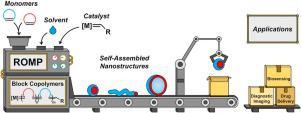Progress in Polymer Science ( IF 26.0 ) Pub Date : 2020-06-20 , DOI: 10.1016/j.progpolymsci.2020.101278 Spyridon Varlas , Stefan B. Lawrenson , Lucy A. Arkinstall , Rachel K. O’Reilly , Jeffrey C. Foster

|
The development of controlled/living polymerization methodologies has underpinned a rapid expanse in our understanding of amphiphilic block copolymer self-assembly. In solution, amphiphilic block copolymers spontaneously organize to form a diverse set of nano-objects, such as spherical and worm-like micelles or vesicles, that have proven to be exceptionally useful in the fields of nanomedicine, sensing, and catalysis, amongst others. The properties of such polymeric assemblies are strongly dependent on the chemical structure of their constituent block copolymer amphiphiles and, by extension, the methodology employed in their synthesis. In the past, research in this area has centered on the use of radical or anionic polymerization strategies to prepare amphiphilic block copolymers. However, continued efforts in the development of living ring-opening metathesis polymerization (ROMP) have facilitated access to new families of block copolymers, primarily based on the polynorbornene scaffold, that provide specific advantages over more traditional block copolymers comprised of (meth)acrylic or styrenic components. This review article provides a comprehensive summary of the synthesis of amphiphilic block copolymers by ROMP and the methods utilized for their self-assembly into ordered nanostructures in solution. In addition, biomedical and biotechnological applications of these ROMP-based block copolymer assemblies are addressed in view of their advantages over nanoparticulate formulations prepared by other methods. Ultimately, this review aims to encourage the utilization of ROMP as a versatile and direct approach to create advanced functional nanomaterials by providing a deep understanding of theoretical and practical aspects relating to its implementation.
中文翻译:

通过开环复分解聚合(ROMP)制备的两亲嵌段共聚物的自组装纳米结构
受控/活性聚合方法学的发展为我们对两亲性嵌段共聚物自组装的理解提供了快速的基础。在溶液中,两亲性嵌段共聚物自发地组织形成各种各样的纳米物体,例如球形和蠕虫状的胶束或囊泡,这些纳米物体已被证明在纳米医学,传感和催化等领域特别有用。此类聚合物组件的性质在很大程度上取决于其组成的嵌段共聚物两亲物的化学结构,并进一步取决于其合成中所采用的方法。过去,该领域的研究集中于使用自由基或阴离子聚合策略来制备两亲性嵌段共聚物。然而,继续进行活性开环易位聚合(ROMP)的开发工作,促进了主要基于聚降冰片烯骨架的嵌段共聚物新家族的获得,与由(甲基)丙烯酸或苯乙烯成分组成的更传统的嵌段共聚物相比,它们提供了特定的优势。 。这篇综述文章全面介绍了通过ROMP合成两亲嵌段共聚物及其在溶液中自组装成有序纳米结构的方法。另外,鉴于这些基于ROMP的嵌段共聚物组件相对于通过其他方法制备的纳米颗粒制剂的优点,解决了它们在生物医学和生物技术方面的应用。最终,











































 京公网安备 11010802027423号
京公网安备 11010802027423号